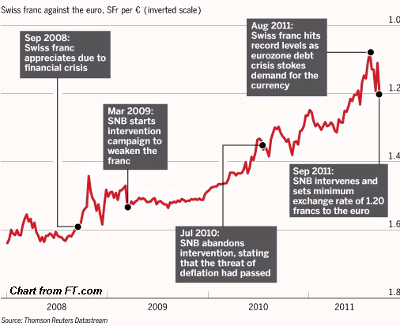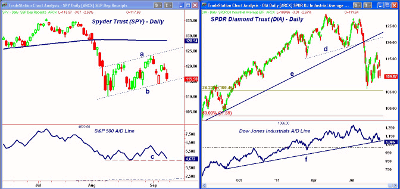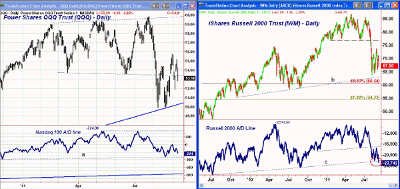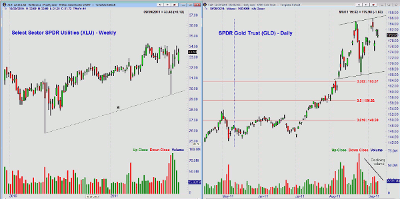A further down move would not be surprising next week, but we're unlikely to see a repeat of August's panic selling, and certain stock groups are still attractive buys, writes MoneyShow.com senior editor Tom Aspray.
After a see-saw week, stocks were punished on again Friday. The action was even worse than what we saw before Labor Day weekend.
This time the financial media reported that stocks were lower because of Obama’s job plan, the surprise resignation of Germany’s top representative on the ECB’s executive board, and worries over a default by Greece.
From a technical standpoint, last week’s action just completed the rebound from the August lows. The sharp drop after the Labor Day weekend caused further deterioration in the technical outlook.
The mid-week rebound—in reaction to a sharp rally in the German Dax index—created another good selling opportunity. The German market was boosted when their constitutional court rejected lawsuits filed to block Germany’s participation in the Eurozone rescue funds. Thursday’s lower close set the stage for Friday’s drop.
If the key support levels are violated early this coming week, it is likely to trigger another wave of selling—but I doubt it will have the panic qualities of what occurred in August.
There was little apparent reaction in the equity markets last week to the surprising decision by the Swiss National Bank to stem the Swiss franc's sharp rise. The safe haven status of the franc has caused a dramatic surge in the currency, not only against the US dollar but also against the euro.
This long-term chart from the Financial Times shows that the Swiss franc has had a dramatic rise against the euro since early in the financial crisis, when it was trading at 1.6 francs/euro. Early attempts to intervene were unsuccessful, and finally they stopped in 2010.
Last month, the franc surged versus the euro and hit parity. After pulling back from these extremes, the franc again started to rally last week, which prompted the Swiss to act. After some slight weakening, the franc started to again turn higher.
The decision to stop the franc from dropping below 1.2 per euro caused a sharp rise in other currencies like the Norwegian krone, as investors looked for another safe haven. While Norway can cut rates to help stem the Krone’s rise, Brazil and Japan have fewer choices.
Brazil just cut rates in the hope that it could escape a global slowdown, while Japan’s rates can’t go much lower. As I discussed last week, Japanese investors have been making a large bet on the Brazilian economy, and negative sentiment on the emerging markets by US investors is making them ones to watch.
Clearly the Eurozone problems are far from being resolved, and more negative developments are likely in the coming weeks. In fact, Greece had to deny on Friday that it would default over the weekend.
Even if we don’t get any more negative about the European debt crisis, the US stock market may have a tough time weathering the economic reports this week. On tap for Tuesday is the import and export prices report, followed by the more important retail sales and producer prices on Wednesday.
Thursday may be the key—we get the Consumer Price Index, Empire State Manufacturing Survey, Industrial Production, the Philadelphia Fed Survey, and of course the jobless claims. It was the Philly survey that rocked the markets last month.
Bonds and gold made new highs last week, though they settled off the best levels. They both are looking a bit toppier; volume has been declining as prices have moved higher. This suggests fewer buyers are pushing prices higher.
NEXT: What to Watch
|pagebreak|WHAT TO WATCH
The very weak market action Friday has caused momentum on stock index futures as well as major ETFs to turn lower. The flag formation are still intact but could easily be completed this week.
Short-term A/D indicators like the McClellan oscillator turned lower ahead of prices, and now show a pattern of lower lows. This makes a further decline quite likely.
In Friday’s Charts In Play, I gave some key levels to watch...and Friday’s lows are in red:
- Spyder Trust (SPY): $114.38 $115.28
- SPDR Diamond Trust (DIA): $109.18 $109.22
- PowerShares QQQ Trust (QQQ): $51.91 $52.85
- iShares Russell 2000 (IWM): $65.93 $66.75
- iShares Dow Jones Transports (IYT): $77.24 $78.33
- November Crude Oil: $83.30 $85.85
S&P 500
The Spyder Trust (SPY) gapped lower again last Friday (that is two Fridays in a row), and closed just above support (line b). A break of support at $114.38 would complete the flag formation (lines a and b) and is likely to trigger heavier selling.
The next downside targets are at $112.41 to $110.27, with the 127.2% downside target from the flag formation at $106.65.
The Fibonacci analysis did a good job of identifying where the rebound would fail, as SPY fell just 20 cents short of the 50% retracement resistance.
The McClellan oscillator (as expected last week) did top ahead of prices, and the rebound in the A/D line last week was anemic. A break of support at line c will be negative.
There is initial resistance now at $118.36 to $120.94.
Dow Industrials
The Spyder Diamonds Trust (DIA) violated converging support (lines d and e) in July. The rebound from the August lows failed well below the 50% retracement resistance.
The lower boundary of the flag formation at $110.40 was broken last Tuesday, which made it likely that a rebound would fail. A drop below last week’s low of $109.18 will suggest a decline to the $105.94 to $105.46 area.
The Dow Industrials A/D line has not yet broken the August lows, but did close the week below the uptrend (line f).
A rebound in DIA is likely to fail between $112.40 and $115.
NEXT: Sector Focus and Tom's Outlook
|pagebreak|Nasdaq-100
The better relative performance of the PowerShares QQQ Trust (QQQ) highlights the better performance of the technology sector.
As I noted last week, QQQ came very close to the 61.8% retracement resistance at $56.07. It is still above the support from last Tuesday’s low at $51.91. The major support is in the $50 to $50.50 area.
The Nasdaq-100 A/D line is acting weaker than prices, but is still above the August lows.
Russell 2000
The small-cap iShares Russell 2000 Index Fund (IWM) was one of the weakest sectors Friday, as it closed just above the minor band of support at $66.50 to $67.50.
Further support sits at $65.93, which corresponds to last week’s lows. The major 50% support stands at $60.54, with the 61.8% support at $54.33.
The Russell 2000 A/D line is leading IWM lower, as it has already broken major support (line c) and the August lows. This is quite negative.
There is near-term resistance at $69.40 to $71.30 that must be surpassed to stabilize the short-term outlook.
Sector Focus
The iShares Dow Jones Transportation Average ETF (IYT) represents one market sector I am watching closely. If the overall market is going to hold at or just under the August lows, then it would not be surprising for IYT to bottom first. There are no signs of this yet.
IYT was hit hard early last week, so the weekly lows at $77.24 are an important level to watch. If they are broken, then the support at $75.81 to $76.40 is likely to be tested.
NEXT: Oil, Metals, and Tom's Outlook
|pagebreak| Sector Focus (Continued)The Select Sector SPDR Utilities (XLU) rebounded impressively from the August panic lows of $29.45 (line b) as it hit a high of $33.80 last week. There is still major resistance in the $34 to $34.30 area (line a). If the overall market declines more, there could be a better risk/reward entry in this sector.
The Select Sector SPDR Consumer Staples (XLP) is also holding well above its lows at $28.07, and has minor support now in the $29.20 to $29.50 area.
Oil
November crude oil dropped below $86, but did close well off the worst levels. The key level to watch is $83.30, which if broken will signal sharply lower crude prices.
Monday’s trading may be important. If crude is not hit with heavier selling, it would be an encouraging sign.
Interest Rates
Down, down, down—that was the path for yields last week. The yield on the ten-year Treasury had a low of 1.89%, which was well below the late 2008 lows. They closed the week at all-time lows.
The yield on the 30-year T-Bond also dropped, but is still well above the lows of 2.5% set during the financial crisis.
Precious Metals
The Spyder Gold Trust (GLD) made new highs last week of $185.85, but closed the week a bit lower. GLD was hit hard mid-week, which may have been in reaction to the threatened intervention to weaken the Swiss franc.
Volume has been declining for the past few weeks, and is not supporting prices. The first good support can be found now at $174.45, and then more important levels are in the $166 area. The 38.2% support from the January 2011 lows is at $163.67.
The iShares Silver Trust (SLV) is still in a shallow uptrend, and with no signs of impulsive action it is looking more vulnerable. If stops under $38 are hit, there could be heavier selling.
The Week Ahead
Last week’s action does not bode well for the equity markets this week, even though they closed off the worst levels on Friday. The momentum has clearly shifted to the downside, and a break of the key support levels outlined above will trigger more selling.
I am not looking for a significant drop below the August lows over the next few weeks. A more likely scenario, in my opinion, is to see some bargain hunting if the August lows are tested.
I expect to see less panic selling. Those who are underinvested in equities should still consider high-yielding big-cap stocks, which offer an attractive total return.
I would definitely not buy either Treasuries or gold right now, as the risk seems way too high at current levels.
- Don't miss Tom's latest Trading Lesson, Using Fibonacci to Trade Flag Patterns
























